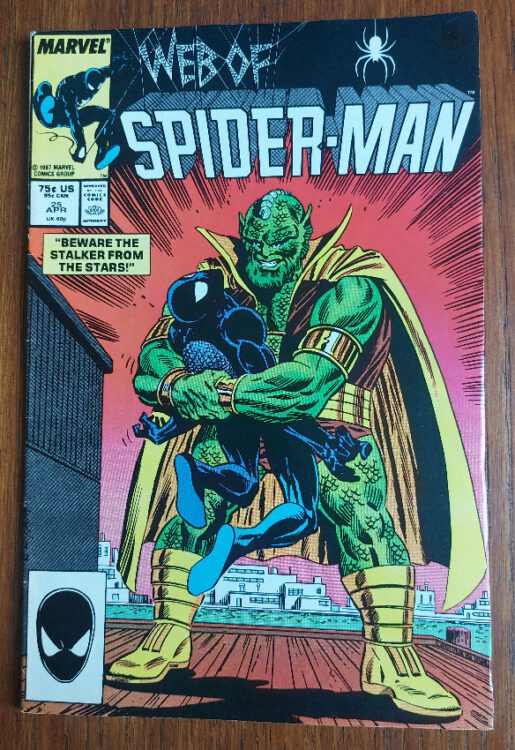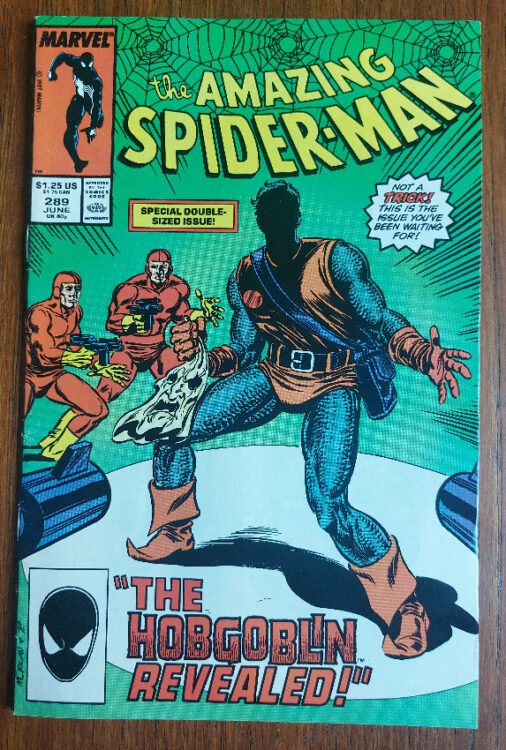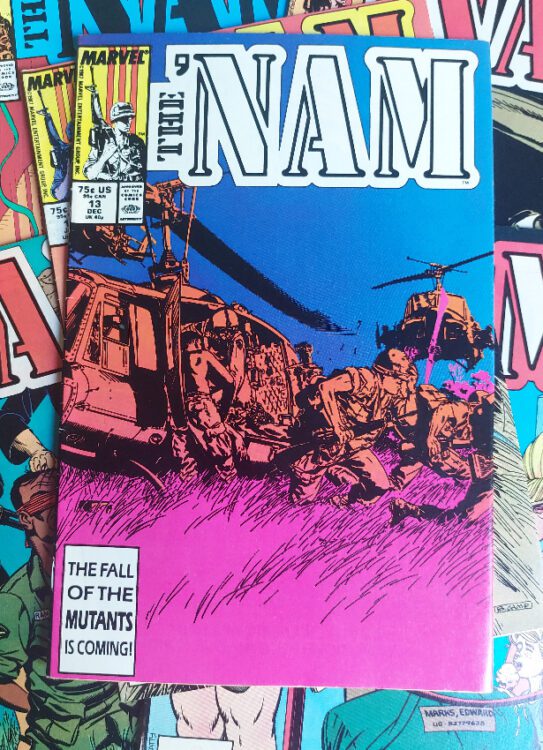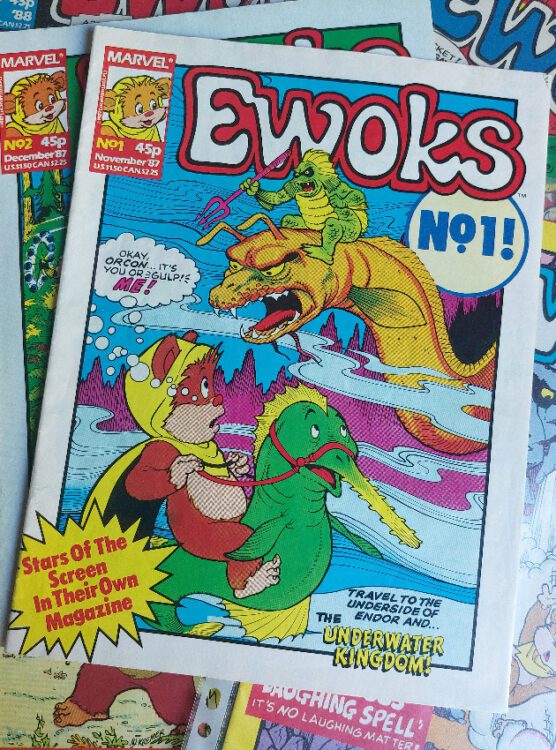The premise is simple: read one comic every day for the entire year. It seems like a simple task but there is no way that I read 365 comics last year, even if you count the individual issues in collections. So, this year, I am committing myself to this reading challenge, in the hope that I can broaden my reading habits and fully engage with my favorite hobby again.
I’m behind on my writing. Not my reading, I’ve easily read 7 comics this week but I have stumbled in my writing. There are two reasons for this (outside of the usual ‘busy with life’ reasons) and they both relate to comics that have garnered strong reactions from readers.
My plan this week, and for the next couple of weeks, was to pick a year and read some of my comics that were published in that year. For no particular reason (that matters) I picked 1987 for this week and started the week off with some Spider-Man comics, you can see my takes below, and then moved onto issue 9 of Watchmen.
Issue 9 is The Darkness of Mere Being and sees Doctor Manhatten travel to Mars to have a chat with Laurie. Some secrets are revealed, pieces of the puzzle start to fall into palace, and the doomsday clock hands move one step closer to midnight.
The problem is, what do you say about Watchmen? Everyone knows that it is one of the most influential American comic books ever published. Even if you are not a fan of the comic itself, you can’t deny that it had a major impact on comic storytelling and the publishing industry. When it was released it changed the way that a lot of people looked at comics and the stories that you could tell, especially in the superhero genre. Alan Moore, Dave Gibbons, and John Higgins used the tropes of superhero comics, and North American comics in general, to reinvent the wheel, so to speak. Each issue was something special and you can see the influence even on today’s creators. However, through the packaging as a graphic novel, the comic also changed the way that publishers sold their comics and contracted their creators. There is plenty written about the ongoing quarrel between Moore and DC comics, or to be fair, the whole comic industry. There are numerous podcasts and journal articles about the different aspects of Watchmen and it’s everlasting influence.
So, what more can you say? And is it fair to write two to three hundred words about one issue and unintentionally marginalize such an important comic? Maybe, later in the year, I can look at the series as a whole and in more depth, but this week trying to write about it clogged me up and pushed me away from my keyboard.

Credit: DC Comics
As a bit of light relief I thought I’d read The Amazing Spider-Man #25 because I have seen a lot of chatter about it and that it is an important issue in the series. Full disclosure: I haven’t really read any new Spider-Man comics in over a decade. I pretty much used the One More Day story line to get out, as I had already dropped most Marvel comics after the Civil War event. With that in mind, it might explain my reaction to #25. I thought it was.. Okay. The story was fine, well written, but not really original material where alternate dimensions are concerned. The fact I grew up with Doctor Who, Star Trek and, more pertinent to this comparison, Buffy the Vampire Slayer, means that I’ve seen all of this before. I guess that the shock elements come from the direct relation to Peter Parker and Mary Jane but (again, emphasizing that I’ve not read the title in years) since when were Peter and MJ a thing again? I thought the comic and the readers had moved on from this? So, there is clearly something going on that none Spider-Man fans are not a party to.
Which is fine, but the difference between the two comics, The Amazing Spider-Man #25 and Watchmen #9 is that the former will be pretty much forgotten, even by Spider-Man fans, in a few years whereas the latter is still a much discussed part of comics history and popular culture.
Trying to write about these two comics has been difficult as I didn’t feel as though I could find anything worthwhile or new to say about either of them. Hopefully, next week I can get my teeth into the comics a bit more. Although, I’m already regretting selecting an issue of the Sandman..

Credit: Marvel Comics
Comic Number 134: The Amazing Spider-Man: Giant Sized Annual #21
The Wedding!
I couldn’t read comics from 1987 and not read some Spider-Man, and obviously the biggest story of the year is Peter and MJ’s wedding. Jim Shooter and David Michelinie play the will-they-won’t-they game throughout most of the issue. The readers gets to read Peter’s inner thoughts as he swings through New York, meeting his friends, and allowing doubt to creep in. Nothing major can happen in his life without him revisiting the worst parts of his past. It is something that we can all relate to.
On top of that, MJ’s journey to the wedding day is fueled by parties and another man trying to woo her away. Her lifestyle is contrasted against Peters, and it looks as though the two are incompatible, However, Shooter and Michelinie concentrate on the two characters, their relationship with each other, and their connections through friends and family. The comic is quite lite on super-heroics despite the cover promising a large hero versus villain stand off.
This is an enthralling read and is exactly why I love this period in Spider-Man history; it’s all about the soap opera.

Credit: Marvel Comics
Comic Number 135: Web of Spider-Man #25
“Beware the Stalker from Beyond the Stars”, because he brings a rather underwhelming story.
This issue sees Peter Parker in his black costume run around the city after an alien who is searching for a super powerful weapon. It has some adventure and the ludicrousness of the plot can almost be forgiven for the tongue in cheek script and commitment by artist Vince Colletta.
This comic feels like it is introducing something more spectacular, as if the brief foray into Spider-Man’s life is the precursor to a much larger story line. But, as far as I am aware, nothing ever came of the alien characters and their intergalactic struggle. Perhaps they turned up in some Guardians of the Galaxy comics or something, who knows?
(according to a quick internet search, they were never seen again. Opportunity wasted? In this case, I think not)

Credit: Marvel comics
Comic Number 136: The Amazing Spider-Man #289
The cover of this special double-sized issue promises the shocking unmasking of The Hobgoblin! Inside, it starts with the fallout from Ned Leeds’ death and the Kingpin faces down one of his foes, while there is an assassin out roaming and Flash Thompson has reached rock bottom. How can it not be exciting?
I don’t know but somehow, Peter David (Writer), Alan Kupperburg, and Tom Morgan (artists) make it an extremely humdrum affair. Compelling scenes, deftly drawn, lead to nothing or the excitement is killed in an instant by overwritten inner dialogue. The worst part of this comic is Spider-Man’s inner voice and his constant reminder to the audience that he is Peter Parker or Spider-Man and he’s not having a good day. The plot is convoluted and reads as if it had been planned by several people who never met each other or even had a conversation. There are moments of brilliance in the artwork but the black hole that is the Hobgoblins face does the opposite of what it is meant to: he is not a terrifying figure to be feared in this comic, he’s a cartoonish Halloween costume.
It might seem that I am being a bit harsh but the reason is that this issue of Amazing Spider-Man is such a disappointment. It promises so much and, being a big fan of the Hobgoblin, I really want to be excited by this. But I can’t. It took me three sittings to read it. Three!
I know from reading about the character that there have always been problems with the Hobgoblin. Different writers and editors have had their own thoughts about who he is and what he stands for. Often Editorials have dictated the course of the story and new writers re-imagined previous incarnations and story lines in a series of mini-retcons. Issue 289 reads like a writer trying to rearrange known facts about characters to prove something new and surprising. It doesn’t work in these pages and hampers what should have been a great comic.
Comic Number 137: Watchmen #9
See the introduction above.
Comic Number 138: The Amazing Spider-Man #25 (legacy 919)
Again, see above.

Credit: Marvel Comics
Comic Number 139: The ‘Nam #13
This comic is a wonderful companion piece to the first issue that I read last week. A mere 13 issues in and Ed Marks is ready to go back to the world. He counts down his days as he welcomes new recruits to his platoon and spends his final few days out in the jungle or holed up at the military camp.
This issue contains deliberate comparisons to the first issue and writer Doug Murray does a wonderful job of showing the reader how much Ed has grown over the last year. Scenes in this issue mirror scenes from the first issue but here Ed has become the relaxed soldier, unperturbed by the violence around him. He has become accustomed to his life as a soldier and the war in Vietnam. There are some scenes that are a little bit questionable, such as a drunken Ed being coerced into visiting a Vietnamese prostitute and having no recollection of it the following morning, but this helps to emphasize the main theme in this comic: acclimatization.
The ‘Nam continued for 71 issues after this one but in some ways this is a good place to finish the series. It has told the story of one young man’s experience of war and the effect it has upon him. There is a satisfactory ending in this issue, one that makes a call back to the opening panels of issue one. It has a sense of closure. The fact it continued is great, but for me, I can read the first 13 issues and experience a full story.

Credit: Marvel UK
Comic Number 140: Ewoks #1
This is another Marvel UK publication, reprinting American comics in a magazine format. Written by David Manak and drawn by Warren Kremer and Jon D’Agostino, this is a child friendly adventure of the month style comic. The artwork and layouts are simple and direct working perfectly for the audience it is aimed at. It’s like the younger sister of the Star Wars comic, or the My Little Pony of George Lucas’ world.
And, when it was released, I loved it.
Reading them today takes me back. They play on my sense of nostalgia and remind me of how I experienced the Star Wars movies when they were released: as a child. I didn’t grow into the massive Star Wars fan but there is still a small part of my childhood that will be eternally linked to the franchise, and it is because of the Ewoks and Droids comics.
This week did not go to plan, reading wise. Although I did manage to read 6 out of 7 comics from 1987. One thing that has become clear is that reading comics is an emotional pastime. It is easy to get wrapped up in the nostalgia of comics and slip into a mindset of older means better. But the truth is, just like music and movies, in fact any media, the majority of the comics produced won’t be remembered passed the generations that grew up on them. And only a select few will reach the heady heights of becoming considered a work of Art. The best thing to do is read what you enjoy reading, keep what you will enjoy reading again, and don’t presume to tell anyone else what they should read and enjoy.

